|
The Tap, Tap, Tap of
the Telegraph
by Bob Brooke
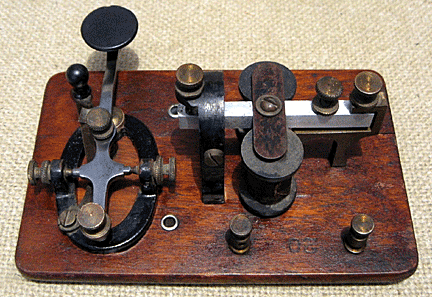 “What
hath God wrought?" The message raced across the telegraph wires in
the form of dots and dashes. With those first words transmitted in
1844, the telegraph became an important feature of daily
communication. Long before the Internet, telegraphy became a global
information network. It was the first binary encoding of data that
traveled over a worldwide web. It was the first time in history that
people did not have to rely on news carried by foot or horseback. “What
hath God wrought?" The message raced across the telegraph wires in
the form of dots and dashes. With those first words transmitted in
1844, the telegraph became an important feature of daily
communication. Long before the Internet, telegraphy became a global
information network. It was the first binary encoding of data that
traveled over a worldwide web. It was the first time in history that
people did not have to rely on news carried by foot or horseback.
Every large city, and most small towns, had a railroad depot
complete with telegraph. Even towns without a railroad station often
had a telegraph office. Before radio, it was a common sight to see.
Folk gathered at the telegraph office to find out the latest
election results or the out-come of a championship boxing match.
Every aspect of life came across the wires - birth, death, war, and
peace.
The Morse Telegraph
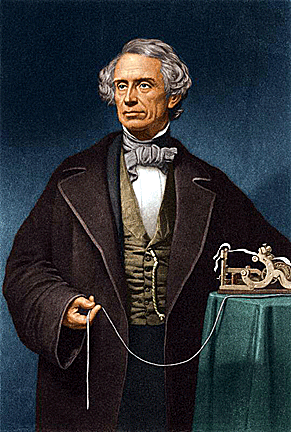 From
1844 almost until World War II, the telegraph was the principal
means of quickly communicating important information across great
distances. Patented in the U.S. in 1837 by Samuel F.B. Morse, who
also devised the famous dots-and-dashes code for tapping out
messages using a telegraph key, the electrical telegraph began as a
small network of telegraph lines owned by Morse’s Magnetic Telegraph
Company, connecting Boston, New York City, Buffalo, Philadelphia,
Baltimore, and Washington, D.C. From
1844 almost until World War II, the telegraph was the principal
means of quickly communicating important information across great
distances. Patented in the U.S. in 1837 by Samuel F.B. Morse, who
also devised the famous dots-and-dashes code for tapping out
messages using a telegraph key, the electrical telegraph began as a
small network of telegraph lines owned by Morse’s Magnetic Telegraph
Company, connecting Boston, New York City, Buffalo, Philadelphia,
Baltimore, and Washington, D.C.
The Morse instruments were simple, consisting of an electromagnet
working an armature and a circuit opening and closing device called
a "key." The first telegraph key was, simply put, a strip of spring
steel that could be pressed against a metal contact to complete an
electrical circuit. Telegraph operators sent these electrical
impulses, made by opening and, closing a circuit, over wires. These
instruments, together with a single line wire between stations and a
battery or other source of direct current power, plus a skilled
operator, were all that was necessary for basic communication. Later
on, wireless telegraph sent the pulses from telegraph keys by radio.
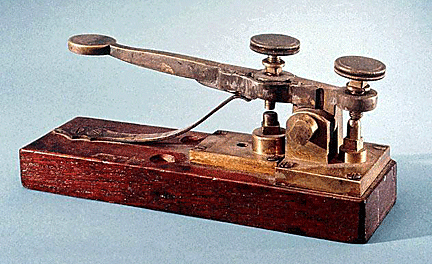 The
telegraph was originally intended as a visual rewarding device to
record the dots and dashes on paper tape. An operator then had to
transcribe the message on the tape to a written message. Since the
recording mechanism generated a clicking sound in operation the
operators gradually learned to read the sound and record the message
directly. This discovery of sound reading, around 1850, overnight
transformed the Morse system into a simple, enormously capable
system that served as the prime means of electrical communication
for over 10 years. The
telegraph was originally intended as a visual rewarding device to
record the dots and dashes on paper tape. An operator then had to
transcribe the message on the tape to a written message. Since the
recording mechanism generated a clicking sound in operation the
operators gradually learned to read the sound and record the message
directly. This discovery of sound reading, around 1850, overnight
transformed the Morse system into a simple, enormously capable
system that served as the prime means of electrical communication
for over 10 years.
The telegraph was even used to keep an exact standard time in every
city and across the country. Every day, for a few minutes before
noon, regular telegraph service was halted on specific wires. The
word 'Time' was transmitted and repeated over and over. Then,
following a short pause, a single dot was sent, confirming the exact
time as noon. The Morse system began to pass out of widespread use
in the 1930s although it continued in use on the railroads until the
mid 1950s.
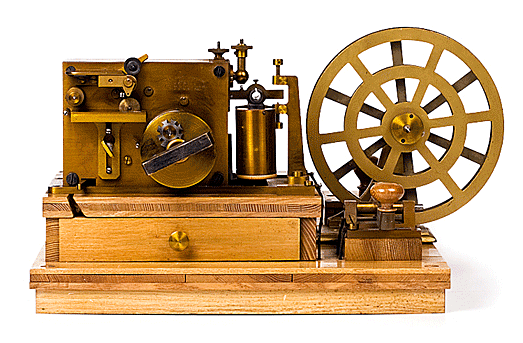
A vast increase in telegraph traffic requiring the use of automatic
machines and changing economic conditions brought about the
disappearance of the simple Morse system. The telegraph industry had
prospered for many years on the premise of low-paid operators working
long hours without overtime pay. At one time, operators accepted these
conditions without question. Then, other types of employment began to
offer higher pay and shorter hours, drawing many young people away from
telegraph employment.
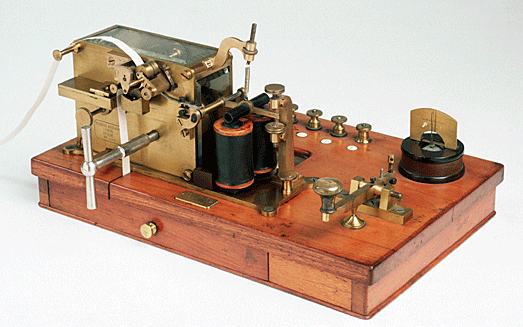
The introduction of printing telegraph machines into even the smaller
local telegraph offices made it possible to employ relatively unskilled
people to operate the typewriter style keyboards of the printers.
Telegraph Equipment Basics
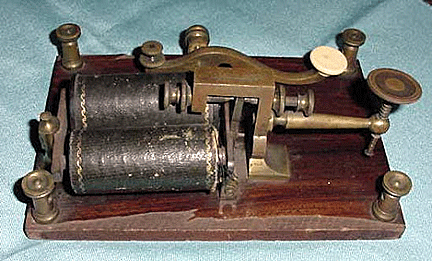 Two
key pieces of hardware defined the telegraph. The first was the
transmitter, also called the key. The operator of this instrument tapped
out messages composed of dots and dashes by alternately closing
(pressing the key) and breaking (releasing it) an electrical circuit. A
quick tap created a dot, while holding the key down for three times as
long created a dash. Two
key pieces of hardware defined the telegraph. The first was the
transmitter, also called the key. The operator of this instrument tapped
out messages composed of dots and dashes by alternately closing
(pressing the key) and breaking (releasing it) an electrical circuit. A
quick tap created a dot, while holding the key down for three times as
long created a dash.
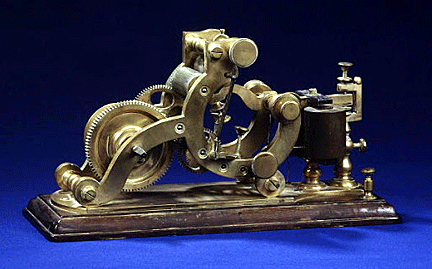 Early
manufacturers of keys included Charles Williams, Jr. of Boston, which
was a hotbed of telegraph technology before the Civil War. Williams
began making telegraph keys in 1850 under the name Hinds and
Williams—the Hinds name was dropped in 1856. In addition to telegraph
instruments, including devices whose humpbacked levers gave them the
nickname “camelback keys,” Williams manufactured hardware for Thomas
Edison, who eventually produced his own telegraph keys from a plant in
Newark, New Jersey. Early
manufacturers of keys included Charles Williams, Jr. of Boston, which
was a hotbed of telegraph technology before the Civil War. Williams
began making telegraph keys in 1850 under the name Hinds and
Williams—the Hinds name was dropped in 1856. In addition to telegraph
instruments, including devices whose humpbacked levers gave them the
nickname “camelback keys,” Williams manufactured hardware for Thomas
Edison, who eventually produced his own telegraph keys from a plant in
Newark, New Jersey.
J.H. Bunnell
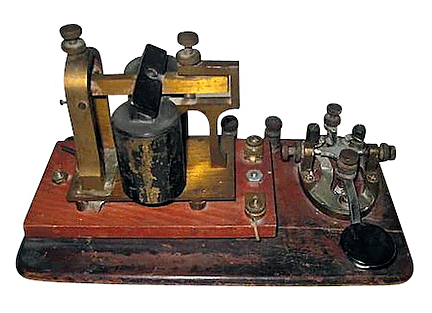 J.H.
Bunnell & Co. was another telegraph-equipment pioneer. From the summer
of 1862 to the fall of 1864, its founder, Jesse Bunnell, was the
personal telegrapher for Union Generals George McClellan and William
Tecumseh Sherman. In 1888, Bunnell's company introduced its double speed
“sideswiper” key, which was developed to help telegraphers suffering
from what was then called "glass arm" but is known today as carpal
tunnel syndrome. In 1906, Bunnell released its Triumph key. J.H.
Bunnell & Co. was another telegraph-equipment pioneer. From the summer
of 1862 to the fall of 1864, its founder, Jesse Bunnell, was the
personal telegrapher for Union Generals George McClellan and William
Tecumseh Sherman. In 1888, Bunnell's company introduced its double speed
“sideswiper” key, which was developed to help telegraphers suffering
from what was then called "glass arm" but is known today as carpal
tunnel syndrome. In 1906, Bunnell released its Triumph key.
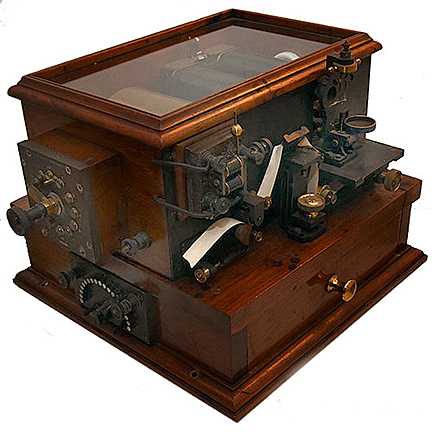 A
register, also called a recorder, received signals sent by the key.
Early versions of this device featured a thin, spring-powered spool of
paper that slowly moved through the machine. As the circuit magnetized a
lever with a point on its end, it would press against the paper, leaving
dots and dashes on its surface, which could be decoded into letters,
numerals, and basic punctuation. A
register, also called a recorder, received signals sent by the key.
Early versions of this device featured a thin, spring-powered spool of
paper that slowly moved through the machine. As the circuit magnetized a
lever with a point on its end, it would press against the paper, leaving
dots and dashes on its surface, which could be decoded into letters,
numerals, and basic punctuation.
There were two types of telegraph keys— straight and semiautomatic, and
among these there are landline keys and the wireless keys. The main
difference between landline and wireless types is the size of the
contacts. Railroad telegraphers and Western Union operators mainly used
landline keys and Western Union operators. Radio operators—both military
and commercial—used wireless keys.
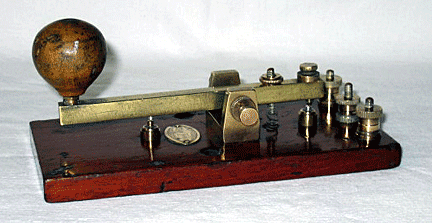 The
straight key is the most common. It operates with an up-and-down motion,
manually creating a series of dots and dashes It came in a variety of
styles, sizes, and colors. Many companies produced telegraph keys,
including Steiner, Phelps, Greeley, Marconi, Murdock, Logan, Johnson,
and McElroy. The
straight key is the most common. It operates with an up-and-down motion,
manually creating a series of dots and dashes It came in a variety of
styles, sizes, and colors. Many companies produced telegraph keys,
including Steiner, Phelps, Greeley, Marconi, Murdock, Logan, Johnson,
and McElroy.
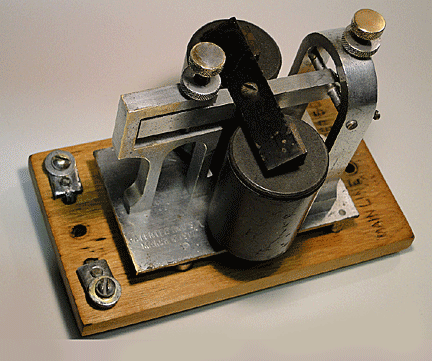 In
the late 1870s, devices known as sounders began to replace paper
recorders. As its name suggests, the sounder allowed a trained operator
to hear the dots and dashes and scribble them down; resonators attached
to the sounder permitted the operator to change the direction or volume
of the sound so messages could be heard clearly. One of the biggest
late-19th-century manufacturers of sounders was Western Electric, which
went on to become the manufacturing arm of the Bell System. This enable
the receiving operator to hear the coded message even in noisy
environments such as a railroad station. In
the late 1870s, devices known as sounders began to replace paper
recorders. As its name suggests, the sounder allowed a trained operator
to hear the dots and dashes and scribble them down; resonators attached
to the sounder permitted the operator to change the direction or volume
of the sound so messages could be heard clearly. One of the biggest
late-19th-century manufacturers of sounders was Western Electric, which
went on to become the manufacturing arm of the Bell System. This enable
the receiving operator to hear the coded message even in noisy
environments such as a railroad station.
Naturally, companies such as Western Electric, Williams, and New Haven
Clock Company combined the key and recorder into a single device known
as the key on board, or KOB. From the early 1910s to early 1920s, higher
voltage spark keys represented the state of the art in telegraph
technology, only to be replaced by semi-automatic keys known as “bugs,”
which had names like Vibroplex and Electro. During World War II, the
military commissioned bugs from model train manufacturer Lionel, among
others.
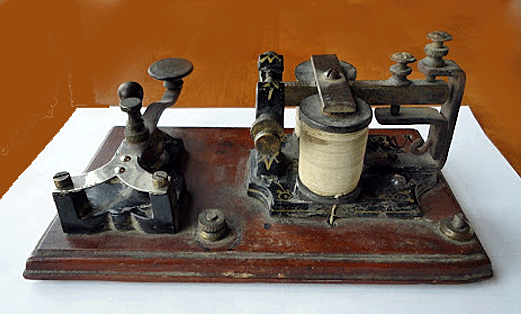
Collecting Old Telegraph Equipment
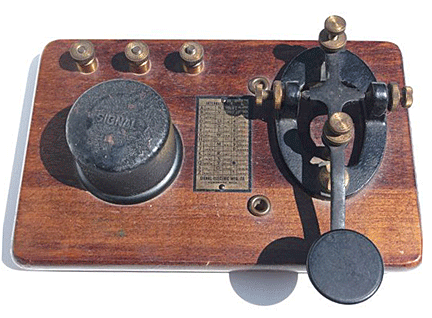 When
the Morse system started to pass out of use. collectors began to realize
that these cast-off instruments were of great historical value. There
was a great quantity of material available for the beginning collector.
Every telegraph office, railroad station and telephone company
contributed to the profusion of instruments available. Often they were
available for the asking by the lucky individual who happened to be in
the right place at the right time. Companies dismantled large city
telegraph offices and sold the entire contents to scrap dealers, who
were quick to realize the collectible value of what they had purchased.
They soon began doing a brisk business selling items to collectors. The
dealers usually made a nice profit in these transactions even though the
prices were nominal compared to today. When
the Morse system started to pass out of use. collectors began to realize
that these cast-off instruments were of great historical value. There
was a great quantity of material available for the beginning collector.
Every telegraph office, railroad station and telephone company
contributed to the profusion of instruments available. Often they were
available for the asking by the lucky individual who happened to be in
the right place at the right time. Companies dismantled large city
telegraph offices and sold the entire contents to scrap dealers, who
were quick to realize the collectible value of what they had purchased.
They soon began doing a brisk business selling items to collectors. The
dealers usually made a nice profit in these transactions even though the
prices were nominal compared to today.
Unfortunately, the great profusion of collectible material that existed
40 or 60 years ago is now gone, yet instruments still turn up at flea
markets, auctions and garage sales. Collectors also sell and trade
instruments with each other. Nineteenth-century instruments now command
high prices. Most of the instruments found today date from around 1910.
The basic telegraph collectibles still rather common today are sending
keys, priced from $25 to $50, relays, priced from $15 to $50, and
sounders, priced from $25 to $50.
Pocket Telegraph Sets
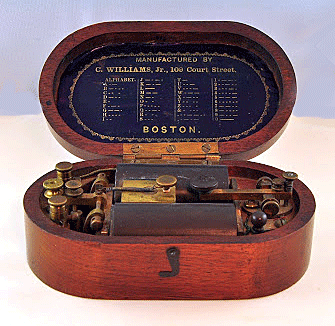 Of
all the rare telegraphic material, perhaps the rarest of the rare are
the tiny pocket instruments. Incorporating most of the features of full
size instruments these little sets are usually less than 6 inches
long—truly pocket instruments. They came into prominence during the
Civil War when so-called "telegraph scouts" used them to tap enemy
telegraph lines. The Caton Instrument Company of Ottawa, Illinois, named
for Judge John Dean Caton, a telegraph pioneer whose Illinois and
Mississippi Telegraph Company, made most of these pocket sets. Of
all the rare telegraphic material, perhaps the rarest of the rare are
the tiny pocket instruments. Incorporating most of the features of full
size instruments these little sets are usually less than 6 inches
long—truly pocket instruments. They came into prominence during the
Civil War when so-called "telegraph scouts" used them to tap enemy
telegraph lines. The Caton Instrument Company of Ottawa, Illinois, named
for Judge John Dean Caton, a telegraph pioneer whose Illinois and
Mississippi Telegraph Company, made most of these pocket sets.
Soldiers in the Civil War made extensive use of the Morse telegraph,
both for communication between major military head-quarters and down to
the smallest units in the field. These simple instruments would operate
over the most rudimentary field lines and constituted a very flexible
communications system for armies moving on foot and by horse power.
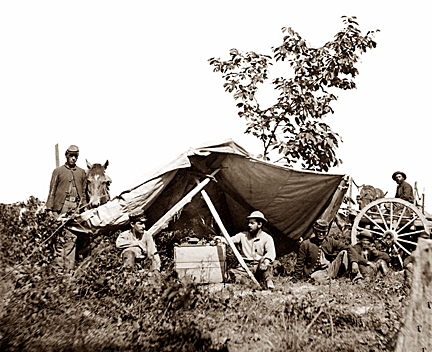
In the early days of the Civil War, the United States didn’t have a
Signal Corps as a separate branch of the army. 'lb meet the rapidly
developing need for telegraphic communication a group of civilian
telegraph operators was formed. Called the Military Telegraph Corps, the
unit functioned throughout the war with great courage and efficiency.
Adventures of the individual operators form some of the most thrilling
stories of the war.
In 1872, Western Electric purchased the Caton Instrument Company and
continued to produce a revised version of these pocket sets, used widely
by telegraph companies and railroads. Telegraph lineman also used these
pocket sets for testing lines in the field. Some linemen were capable
telegraphers and could use the tiny instruments to communicate directly
with the wire chief while others, who didn’t know Morse Code, used the
sets to test for voltage on the lines.
Almost all of the principal telegraph equipment manufacturers, including
Bunnell and Tillotson, manufactured pocket telegraph sets. The Postal
Telegraph company made a substantial looking oak cased pocket set solely
for the use of postal linemen and didn’t sell them outside of the
company. All of these pocket sets are so rare today that they seldom
change hands, making it difficult to establish a price level. And even
when they do, the price seldom falls below $200 and can be much higher
depending on the condition of the set.
Collecting Telegraphic Equipment
With such a long life, telegraphy has left collectors plenty of
historical equipment to be. discovered. Although not common, many
telegraphy keys and related items from the earliest days remain. Those
from the 20th century can be found easily.
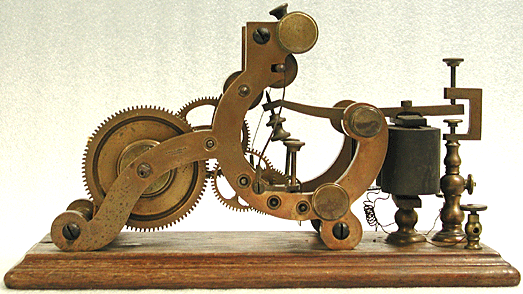
Very few records exist today to tell collectors which manufacturers made
what models or how many. Many telegraph keys bear no identifying marks.
Some have a model number and, with a little research, a collector can
determine the manufacturer.
<
Back to More Antique Spotlights
Next Article >
|
